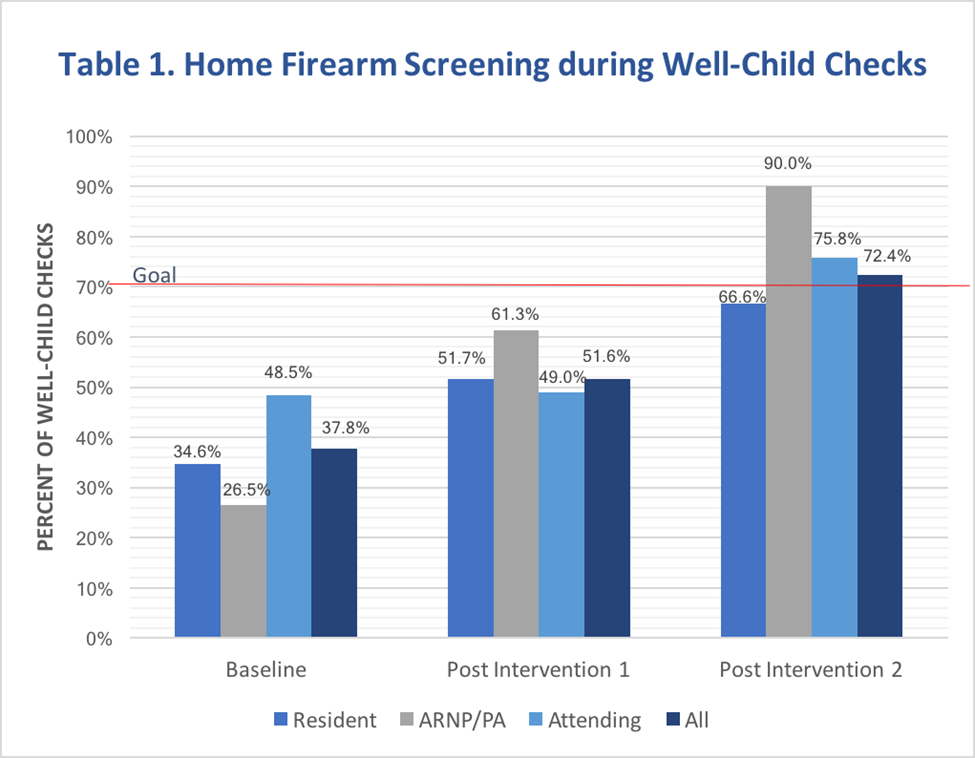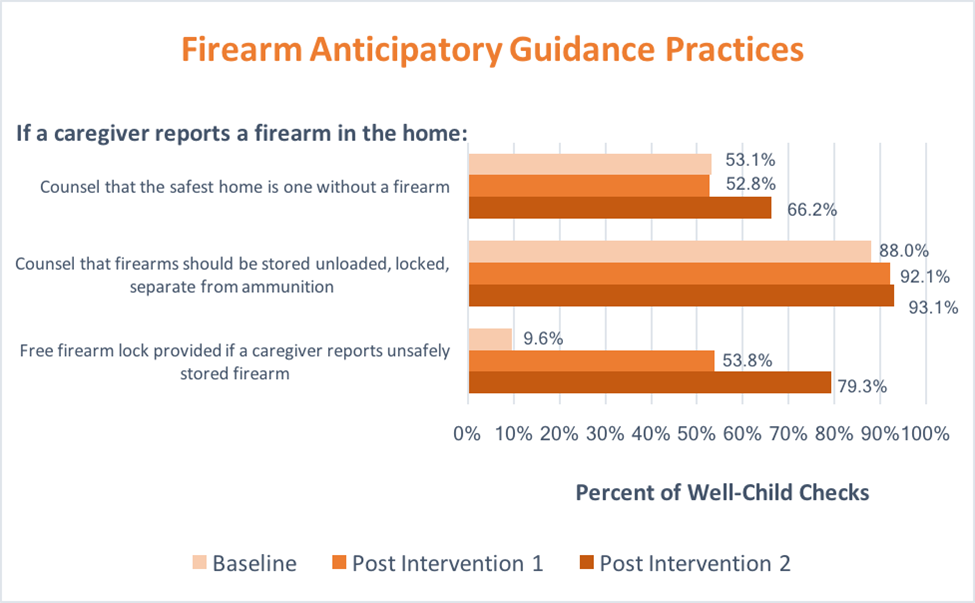Research to be presented at the 2021 American Academy of Pediatrics National Conference & Exhibition finds staff training programs at hospitals and clinics and gun safety educational materials dramatically increased doctor/parent conversations about gun safety
ITASCA, IL – Firearms are the number one cause of death in American children and adolescents, and new research shows that training programs and other supports help doctors consult parents on how to prevent these injuries.
The study abstract, “Improving Firearm Screening and Anticipatory Guidance During Well-Child Checks: A Resident-Led Quality Improvement Project,” will be presented at the virtual American Academy of Pediatrics National Conference & Exhibition. Researchers found a program that offered free firearm locks for distribution, in addition to educational materials on firearm safety, increased the likelihood pediatricians would counsel parents about gun safety.
“Firearms are the number one cause of death in American children and adolescents. It is essential that pediatricians discuss firearm safety with families at well-child checks,” said Alexandra Byrne, MD, the abstract author and a pediatric resident at the University of Florida, Gainesville. “With the rise in firearm sales and injuries during the COVID-19 pandemic, it is more important than ever that pediatricians address the firearm epidemic.”
The research showed that when a hospital offered gun safety materials and training, it had a significant impact on the gun safety conversations happening between doctors and parents:
- Pediatrician firearm screenings increased from 37.8% to 72.4%,
- Free firearm lock giveaways increased from 9.6% to 79.3%,
- Counseling that the safest home is one without firearms increased from 53.1% to 66.2%,
- Counseling on safe firearm storage increased from 88.0% to 93.1%.
This research is important, because previous studies have found that counseling and providing families with free firearm locks during visits increases safe storage practices and that safe storage reduces firearm injuries. The American Academy of Pediatrics recommends that pediatricians ask about the presence of firearms in the home and discuss firearm safety at well-child visits.
“Our study demonstrates effective ways to improve firearm screening during well-child checks,” Dr. Byrne said.
Dr. Byrne will present the study abstract at 1:10 p.m. CT Saturday, October 9, 2021.
The research was supported by the Moms Demand Action for Gun Sense in America, Gainesville Florida Chapter, which donated the firearm locks and Be SMART gun safety educational materials that were used in the research.
To request an interview, journalists may contact Ken Garcia, UF Health Communications Media Relations.
Please note: only the abstract is being presented at the meeting. In some cases, the researcher may have more data available to share with media or may be preparing a longer article for submission to a journal.
# # #
The American Academy of Pediatrics is an organization of 67,000 primary care pediatricians, pediatric medical subspecialists and pediatric surgical specialists dedicated to the health, safety and well-being of infants, children, adolescents and young adults. For more information, visit www.aap.org.
Program Name:
Abstract Title: Improving Firearm Screening and Anticipatory Guidance During Well-Child Checks: A Resident-Led Quality Improvement Project
Alexandra Byrne
Gainesville, FL, United States
Saturday, October 9, 2021: 1:10 PM –
Background: Firearms are the leading cause of death in American children and adolescents. The American Academy of Pediatrics (AAP) recommends that pediatricians ask about the presence of firearms in the home at well-child visits and advises that homes without firearms provide the most effective measure to prevent firearm-related injuries. The AAP recommends safe storage for homes with guns. Despite these recommendations, pediatrician firearm screening remains low. A recent randomized control trial found a significant increase in safe firearm storage when pediatricians provided free firearm locks and counseled on firearm removal and safe storage. Objective: Increase firearm screening (asking about home firearms) from roughly 40% to 70% and also increase counseling on firearm removal, safe storage and provision of free firearm locks during pediatric well-child checks over eight months.
This quality improvement project (QIPR #1389) used the plan-do-study-act (PDSA) methodology and included two sequential interventions: First, the entire department received didactic training on firearm safety and evidence-based recommendations for firearm screening and anticipatory guidance, and clinics received free firearm locks. Thereafter, clinics received Be SMART© posters and educational cards from the national educational campaign for firearm safety. To assess the project, pediatric residents, PAs/APRNs and attendings in the General Pediatrics Division at the University of Florida received three anonymous, electronic, six-question surveys spaced three to four months after each PDSA intervention to evaluate firearm screening and anticipatory guidance practices from 10/2020-6/2021.
Response rates overall were 43.8% (survey 1: 58.4% (n=52); survey 2: 47.2% (n=42); survey 3: 25.8% (n=23). At baseline, pediatric providers cited firearm screening during a third (37.8%) of well-child checks. If a parent/caregiver reported a firearm in the home, only half (53.1%) at baseline counseled that the safest home for a child is one without firearms. Most pediatricians (88.0%) reported counseling that firearms should be stored unloaded, locked, and separate from ammunition. Firearm locks were offered only at 9.6% of visits. After two PDSAs, reports of firearm screening significantly improved (37.8% to 72.4%) as did free firearm lock provision (9.6% to 79.3%), exceeding our 70% goal (see Tables 1 and 2). Anticipatory guidance also improved: counseling that the safest home is one without firearms increased (53.1% to 66.2%) and counseling on safe firearm storage remained high (increasing from 88.0% to 93.1%). Increased screening significantly improved across all pediatric provider types (resident, PA/APRN, attending).
At baseline, pediatricians infrequently screened for home firearms, consistent with previous studies. After PDSA interventions, this quality improvement study demonstrated that department-wide training on firearm safety and screening recommendations, free firearm locks, and Be SMART© materials are effective ways to improve firearm screening and anticipatory guidance during well-child checks in an academic primary care center. Future studies will measure the sustainability of these interventions.
Table 1

Home Firearm Screening during Well-Child Checks
Table 2

Firearm Anticipatory Guidance Practices